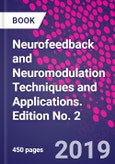Neurofeedback and Neuromodulation Techniques and Applications, Second Edition, presents the latest techniques, analysis and applications to specific patient populations and disorders. The book will serve as an extensive reference on neuromodulation techniques with its discussions on innovative applications that either currently exist or are in development. Top scholars in the field offer both the breadth needed for an introductory scholar and the depth desired by a clinical professional. This information is critical for neurosurgeons, neuropsychologists, neurophysiologists, clinical psychologists, and other proceduralists, providing a clear presentation of the frontiers of this exciting and medically important area.
- Includes techniques to use with patients
- Integrates neurofeedback with neuromodulation techniques
- Discusses what the technique is, for which disorders it is effective, and the evidence basis behind its use
- Written at an appropriate level for clinicians and researchers
- Provides updates from the earlier edition, including more advanced assessment and intervention techniques
Table of Contents
Part One: Neuromodulation: Analysis Techniques 1. Assessment of EEG (QEEG) and brain arousal: Relevance for diagnosis, prognosis, and treatment in neuropsychiatry 2. Use of Databases in Quantitative EEG Evaluation: An Update 3. LORETA Current Source Density: Implications for Diagnostic and Clinical Utility 4. Advances in the Measurement of EEG Connectivity
Part Two: Endogenous Neuromodulation Strategies 5. Feedback of Slow Cortical Potentials: Basics, Application and Evidence 6. Four Channel Multivariate Coherence Training: Theory and Empirical Evidence 7. Emerging Empirical Evidence Supporting Connectivity-Guided Neurofeedback for Autistic Disorders 8. Seizures, Epilepsy and Neurofeedback 9. Quieting the Cacophony: Trauma, Disordered Arousal, and Neurofeedback 10. Evidence Supporting Neurofeedback for Adult Psychiatric Disorders 11. Real-Time Regulation and Detection of Brain States from fMRI Signals
Part Three: Exogenous Neuromodulation Strategies 12. Repetitive Transcranial Magnetic Stimulation in Depression: Protocols, Mechanisms, and New Developments 13. Transcranial Magnetic Stimulation for Tinnitus 14. Neurophysiological Effects of Transcranial Direct Current Stimulation 15. Effects of rTMS and Neurofeedback on Gamma Frequency Activity in Children with Autism Spectrum Disorder
Part Four: Mechanism of Change and Long-Term Consolidation: Beginning Evidence 16. Functional Neuroimaging Evidence Supporting Neurofeedback in ADHD 17. Self-Tuning the Brain towards Criticality? Restoring Long-Range Temporal Correlations with Neurofeedback 18. Enduring Effects of Neurofeedback in Children








